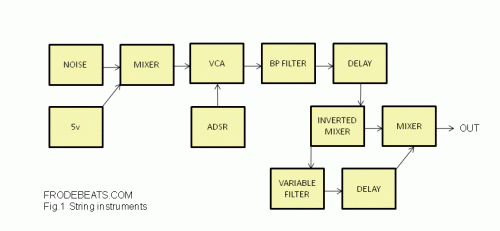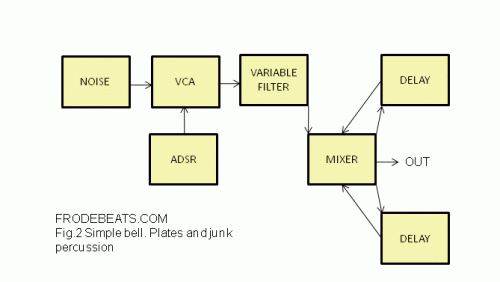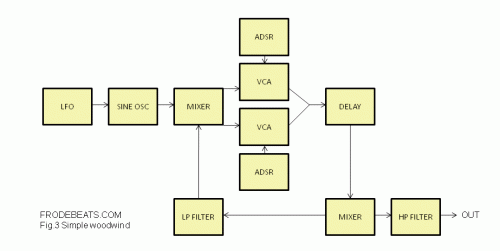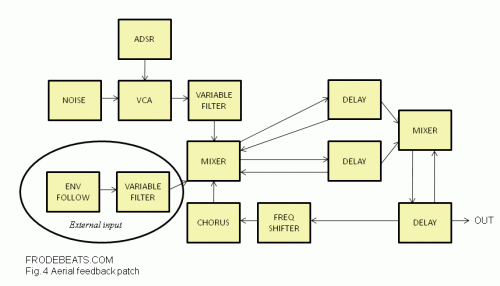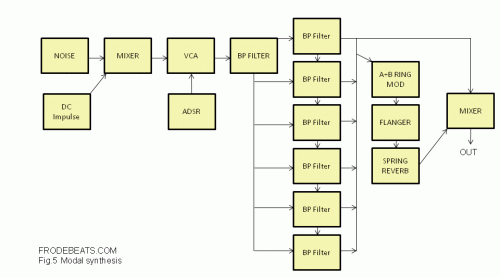Sound innovation and virtual instruments
Karplus-Strong string synthesis is a method of physical modelling synthesis that loops a short waveform through a filtered delay line to simulate the sound of strings.
It`s a synthesis technique suitable for BBD delays as well as digital delay units. I`m using the Karplus-Strong theory as a base. These techniques have been developed further by, amongs others; Ron Berry ( http://www.ron-berry.co.uk/ ) and Julius Smith. By using several delays in feedback loops you can obtain a vast collection of string instruments, percussion and sound effects. The simple models below are good starting points for acoustic modeling. I`m not a great fan of trying to play stairway to heaven on modular synth, but the knowledge of the emulation of real instruments is a great basis for sound design.
You can create guitars, woodwinds, pianos - but even better - You can create - THE SOUNDS OF MONSTERS!! Even ghosts, machines, aerial stuff and the whole arsenal of Einsturzende Neubauten percussion. No need to get your hands dirty at all.
Figure 1: Normally used for guitar, simple piano and other string instruments. But great for tubes, wooden surface percussion and airy moods. If the one of the delays, preferable a flanger have the possibility of inversion you get a great scope of sounds. Play with filter settings for darker sounding sounds.
Filter settings are crucial in Fig 2. Driving it with high resonance and a fairly closed LP filter gives you simple bells and metal. It`s a simple model, but difficult to get good sounds out of, but work with it and it will be your GOD.
Fig 3 is an adoptation of Ron Berry`s wonderfull trumpet patch. The VCA`s give a nice squaring effect that resonates very well in the delay. Gives great snoaring monsters, ghost cries across the valley, elephants and ... trumpetlike instruments.
Ghosts, old strings, movie darkness and flying textures. Complex and difficult to control. More experimental, but it takes the priciples to the next level.
Physcial modeling using analog BBD`s is a fragile (and sometimes frustrating) teqnique, it`s noisy and difficult to control on an analog system. Another approach is Modal synthesis using BP filters. Just like the Karplus-Strong model you send an exciter to a responding sound generator, but instead of using delays you use a bank of resonating BP filters in parallel. Each resonator has a unique frequency and gain. The drawback of using this tequnique on an analog system is the number of bandpass filters needed. For a convincing string sound something like 100 would be appropriate. But using just 6 BP filters gives you great pads, glasslike sounds, marimba, xylophone, bells, formants and percussion. If you happen to have 20 BP filters you can also begin experiments on those string sounds. Take a look at this:
A very simplified modal synthesis model. I`ve stayed clear of delay feedback loops (and other loopback teqniques), cause i think this defeats the purpose and would make this an even more frustating approach to physcial modeling that the above models.
Using analog systems as a sound design tool should spark creativity and not send you diving towards the abyss. Using simplified models and making the most of them often yields better results. I`ve made better cymbals using 9 oscillators than computorized 3d waveguide models. it`s more important using creativity and ears than loosing your wife, kids and dog patching a single sound on a million dollar modular. You can spend weeks on a single sound if you really have a go at it.
If you don`t have delays you can obtain some rather nice modeling sounds using simple subtractive teqniques. These examples is made with only oscillators and noise source.


